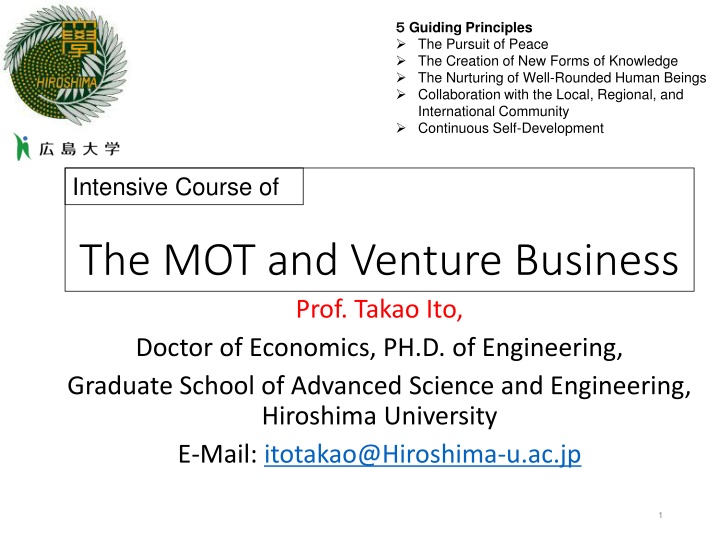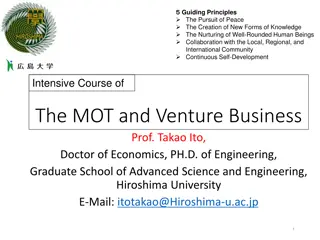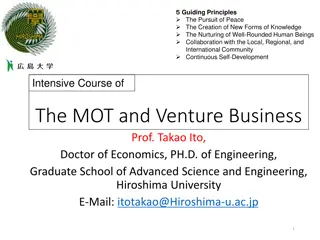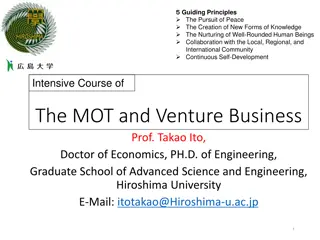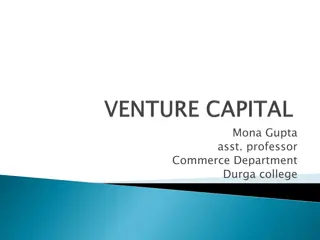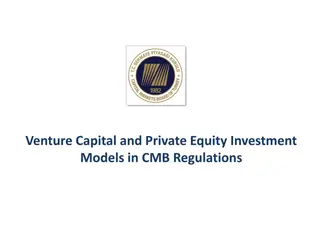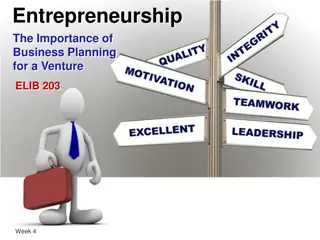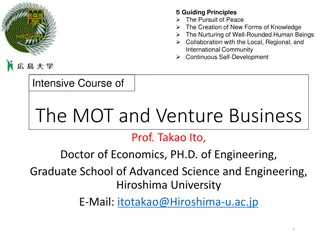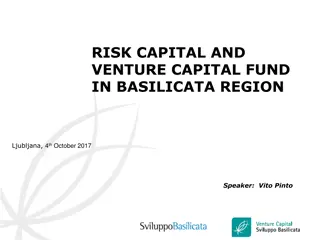Intensive Course on MOT and Venture Business with Prof. Takao Ito
Explore the guiding principles for peace, creation of new knowledge, and nurturing well-rounded individuals in an intensive course on MOT and Venture Business led by Prof. Takao Ito. The course covers topics such as management evolution, corporate issues, cost analysis, leadership, and business planning. Discover key planning elements, marketing strategies, and forecasting techniques essential for a successful business plan. Learn from the wisdom of investing in people over ideas and embark on a journey of continuous self-development and collaboration within the global community.
Download Presentation

Please find below an Image/Link to download the presentation.
The content on the website is provided AS IS for your information and personal use only. It may not be sold, licensed, or shared on other websites without obtaining consent from the author.If you encounter any issues during the download, it is possible that the publisher has removed the file from their server.
You are allowed to download the files provided on this website for personal or commercial use, subject to the condition that they are used lawfully. All files are the property of their respective owners.
The content on the website is provided AS IS for your information and personal use only. It may not be sold, licensed, or shared on other websites without obtaining consent from the author.
E N D
Presentation Transcript
Guiding Principles The Pursuit of Peace The Creation of New Forms of Knowledge The Nurturing of Well-Rounded Human Beings Collaboration with the Local, Regional, and International Community Continuous Self-Development Intensive Course of The MOT and Venture Business Prof. Takao Ito, Doctor of Economics, PH.D. of Engineering, Graduate School of Advanced Science and Engineering, Hiroshima University E-Mail: itotakao@Hiroshima-u.ac.jp 1
Schedule MOT and Venture Business (An Intensive Course) 08:50-16:20, Saturday and Sunday No. Date 1 2023/10/21Sat Outlines and Introduction 2 2023/10/21Sat The evolution of Management 3 2023/10/21Sat Key Issues in Corporate Management 4 2023/10/21Sat Break-Even Point Analysis 5 2023/10/22Sun Cost Benefit Analysis and Ethics 6 2023/10/22Sun Stock Control 7 2023/10/22Sun Case Studies and Group Discussion 8 2023/10/22Sun Kaizen and Quality Control 9 2023/11/11Sat Motivation (self Learning) 10 2023/11/11Sat Organization Structure 11 2023/11/11Sat Decision-making and Strategy 12 2023/11/11Sat Leadership 13 2023/11/12Sun Business Plan 14 2023/11/12Sun Entrepreneur and Venture Business 15 2023/11/12Sun Presentation and/or Final Examination 16 2023/11/12Sun Review and Free Discussion Lecture 08:50-10:20 10:30-12:00 13:10-14:40 14:50-16:20 08:50-10:20 10:30-12:00 13:10-14:40 14:50-16:20 08:50-10:20 10:30-12:00 13:10-14:40 14:50-16:20 08:50-10:20 10:30-12:00 13:10-14:40 14:50-16:20 3
Topic 13 Business Plan Marketing and forecasting
Agenda 1. 2. 3. 4. 5. 6. Key Planning Elements of Business Plan Other Issues of Business Plan Marketing Forecasting and Complex Systems Theory Uncertainty and Illusions Prospect Theory 5
Key Planning Elements of Business Plan the finance the idea the People the Opportunity the Competition the Context the risk and reward
The People The people should be energetic and have skills and expertise directly relevant to the venture More important even than the idea Arthur Rock a legendary venture capitalist who helped start Intel, Teledyne and Apple I invest in people, not ideas. If you can find good people, if they re wrong with the product, they ll make a switch.
Opportunity The opportunity should provide a competitive advantage that can be defended. Customers are the focus here: who is the customer? How does the customer make decisions? How will the product be priced? How will the venture reach all customer segments? How much does it cost to acquire and support a customer, and to produce and deliver the product? How easy or difficult is it to retain a customer?
The competition It is essential to fully consider competition. The plan must identify current competitors and their strengths and weaknesses, predict how they will respond to the new venture potential competitors, and consider how to collaborate with actual or potential competitors. Andrew Busey created ichat which became the leading provider of software for chatroom. American Online and Microsoft started competing directly with him. Busey responded by collaboration with IBM; the Lotus division bundled ichat s software with its Internet-ready version of Notes.
Context It should be favorable one from regulatory and economic perspectives. Such factors as tax policies, rules about raising capital, interest rates, inflation, and exchange rates will affect the viability of the new venture. It can make it easier to get backing and to succeed. Your plan should make clear that you know that the context inevitably will change, how the changes will affect the business, and how you will deal with the exchanges.
Risk and reward The risk should understood and addressed as fully as possible. The future is always uncertain, and the elements described in you plan will change over time. Although you cannot predict the future, you must contemplate head-on the possibilities of key people leaving, interest rates changing, a key customer leaving, or a powerful competitor responding ferociously. Describe what you will do to prevent, avoid, or cope with such possibilities.
Discussions You should speak out to the end of the process: how to get money out of the business eventually. Will you go public? Will you sell or liquidate? What are the various possibilities for investors to realize ultimate gains?
Other Issues of Business Plan Selling the plan Nonfinancial resources
Selling the plan Your goal is to get investors to support the plan. Passive investors will give them money and let them do what they want. Professional venture capitalists do not, as they demand more control and more of the returns. But when a business goes wrong- and chances are, it will nonprofessional investors are less helpful. Sophisticated investors have seen sinking ships before and know how to help.
Nonfinancial resources Legitimacy Networks Top management team Advisory boards Partners
Legitimacy Liability of newness A business is legitimate if its goals and methods are consistent with societal value. When the market confers legitimacy, it helps overcome the liabilities of newness . Legitimacy helps a firm acquire other resources such as top managers, good employees, financial resources, and government support.
Networks The entrepreneur is aided greatly by having a strong network of people. Social capital- being part of a social network, and having a good reputation- helps entrepreneurs gain access to useful information, gain trust and cooperation from others, recruit employees, form successful business alliance, receive finding from venture capitalists, and become more successful.
Top management teams The board of directors improves the company image, develops long-term plans for expansion, supports day-todays activities, and develops a network of information sources. Michael Dell founder of Dell Computer at age 19; he hired managers who were far more experienced than he and prominent and powerful board members.
Advisory boards Anita Brattina thought after two or three years of running her own marketing firm she would have lots of cash, no debt, and time to enjoy her independence. Eight years later, she still worked 50 to 60 hours a week and was not making much money. So she got an advisory. Board member taught her to do cash-flow analysis, suggested some strategic changes, and encouraged her to cultivate relationship with a banker, an accountant, and am attorney. In addition, the helped her interview with salespeople, develop a long-term marketing strategy, and reorganize operations. They also vetoed a number of her ideas. Sales went up, after one year of listening to the board and implementing its idea.
Partners Often two people go into business together as partners. Partners can help one another access capital, spread the workload, share the risk, and share expertise. Mark talked three of his friends into joining him in starting his own telecommunication company because he did not want to try it alone. While he wanted to put money into growing the business, his three partners wanted the company to pay for their cars and meeting s in the Bahamas. The company collapsed. I never thought a business relationship could over-power friendship, but this one did. Where money s involves, people change.
Marketing Marketing is a "social and managerial process by which individuals and groups obtain what they need and want through creating and exchanging products and values with others."
4P in Marketing Product Solution Promotion Information Price Value Placement Access
Reviewing Marketing Concepts DIRECT MARKETING ADVERTISING TELEMARKETING PUBLIC RELATIONS BRAND RECOGNITION CUSTOMER FEEDBACK DEMAND AND SUPPLY GAP COMPETITION EATING INTO YOUR MARKET SHARE NEW MARKET ENTRY BARRIERS 11-24
Reviewing Marketing Concepts You see a gorgeous girl at a party. You go up to her and say: "I am very rich. Marry me!" DIRECT MARKETING You're at a party with a bunch of friends and see a gorgeous girl. One of your friends goes up to her and pointing at you says: "He's very rich. Marry him." ADVERTISING You see a gorgeous girl at a party. You go up to her and get her telephone number. The next day, you call and say: "Hi, I'm very rich. Marry me." TELEMARKETING 11-25
Reviewing Marketing Concepts You're at a party and see gorgeous girl. You get up and straighten your tie, you walk up to her and pour her a drink, you open the door (of the car) for her, pick up her bag after she drops it, offer her ride and then say : "By the way, I'm rich. Will you marry me?" PUBLIC RELATIONS You're at a party and see gorgeous girl. She walks up to you and says: "You are very rich! Can you marry me?" BRAND RECOGNITION 11-26
Reviewing Marketing Concepts You see a gorgeous girl at a party. You go up to her and say: "I am very rich. Marry me!" She gives you a nice hard slap on your face. CUSTOMER FEEDBACK You see a gorgeous girl at a party. You go up to her and say: "I am very rich. Marry me!" And she introduces you to her husband. DEMAND AND SUPPLY GAP 11-27
Reviewing Marketing Concepts You see a gorgeous girl at a party. You go up to her and before you say anything, another person comes and tells her: "I'm rich. Will you marry me?" and she goes with him COMPETITION EATING INTO YOUR MARKET SHARE You see a gorgeous girl at a party. You go up to her and before you say: "I'm rich, Marry me!" your wife arrives. NEW MARKET ENTRY BARRIERS 11-28
Forecasting and Complex Systems Theory Chaos Theory Automaton language Percolation model Fractal dimension 11-29
Chaos: a state of utter confusion or disorder; a total lack of organization or order. Automaton: a mechanical figure or contrivance constructed to act as if by its own motive power; robot. 11-30
Percolation: the act or state of causing (a liquid) to pass through a porous body; filter. Fractal: a geometrical or physical structure having an irregular or fragmented shape at all scales of measurement between a greatest and smallest scale such that certain mathematical or physical properties of the structure, as the perimeter of a curve or the flow rate in a porous medium, behave as if the dimensions of the structure (fractal dimensions) are greater than the spatial dimensions. 11-31
Fractal dimension: It is a ratio providing a statistical index of complexity comparing how detail in a pattern (strictly speaking, a fractal pattern) changes with the scale at which it is measured. 11-32
Application of Complex Systems Theory: Basic Concept of Dimension For instance, measuring a line using first one measuring stick then another 1/3 its size, will give for the second stick a total length 3 times as many sticks long as with the first. This holds in 2 dimensions, as well. If one measures the area of a square then measures again with a box of side length 1/3 the size of the original, one will find 9 times as many squares as with the first measure. Such familiar scaling relationships can be defined mathematically by the general scaling rule in Equation 1, where the variable N stands for the number of new sticks, \epsilon for the scaling factor, and D for the fractal dimension: Fig. 1 Dimension 11-33
Such familiar scaling relationships can be defined mathematically by the general scaling rule in the following Equation, where the variable N stands for the number of new sticks, epsilon for the scaling factor, and D for the fractal dimension: N D log N = = log N D log
Application of complex systems theory Basic concept: Dimension ?1= log? log?= log3 = 1 log1 3 ?2= log? log?= log9 = 2 log1 3 ?3= log? log?= log27 = 3 log1 3 Fig. 1 Dimension 11-35
Fractal Dimension 1 log ( ) N = lim D 0 log File:Sierpinski Triangle.svg Fig. 2 Koch curve=snowflake Fig. 3 Sierpinski triangle D=1.262 D=1.585 11-36
Fractal Dimension=1/Hurst Index H<0.5 H=0.5 H>0.5 Hurst index Short-term memory Long-term memory Random
5. Uncertainty and Illusions Vase and Two Persons
My Wife and My Motherin-law http://upload.wikimedia.org/wikipedia/commons/thumb/4/4d/German_postcard_from_1888.png/150px-German_postcard_from_1888.png http://upload.wikimedia.org/wikipedia/commons/thumb/b/ba/Advertisement_Anchor_Buggy_Company_1890_.png/150px-Advertisement_Anchor_Buggy_Company_1890_.png
6. Prospect Theory A theory that people value gains and losses differently and, as such, will base decisions on perceived gains rather than perceived losses. Thus, if a person were given two equal choices, one expressed in terms of possible gains and the other in possible losses, people would choose the former.
Example Expectation value is same 90 A case: E(x)=0.9*100=90 B case: E(x)=0.1*900=90
Thank you for your attention! Thank you for your attention!
